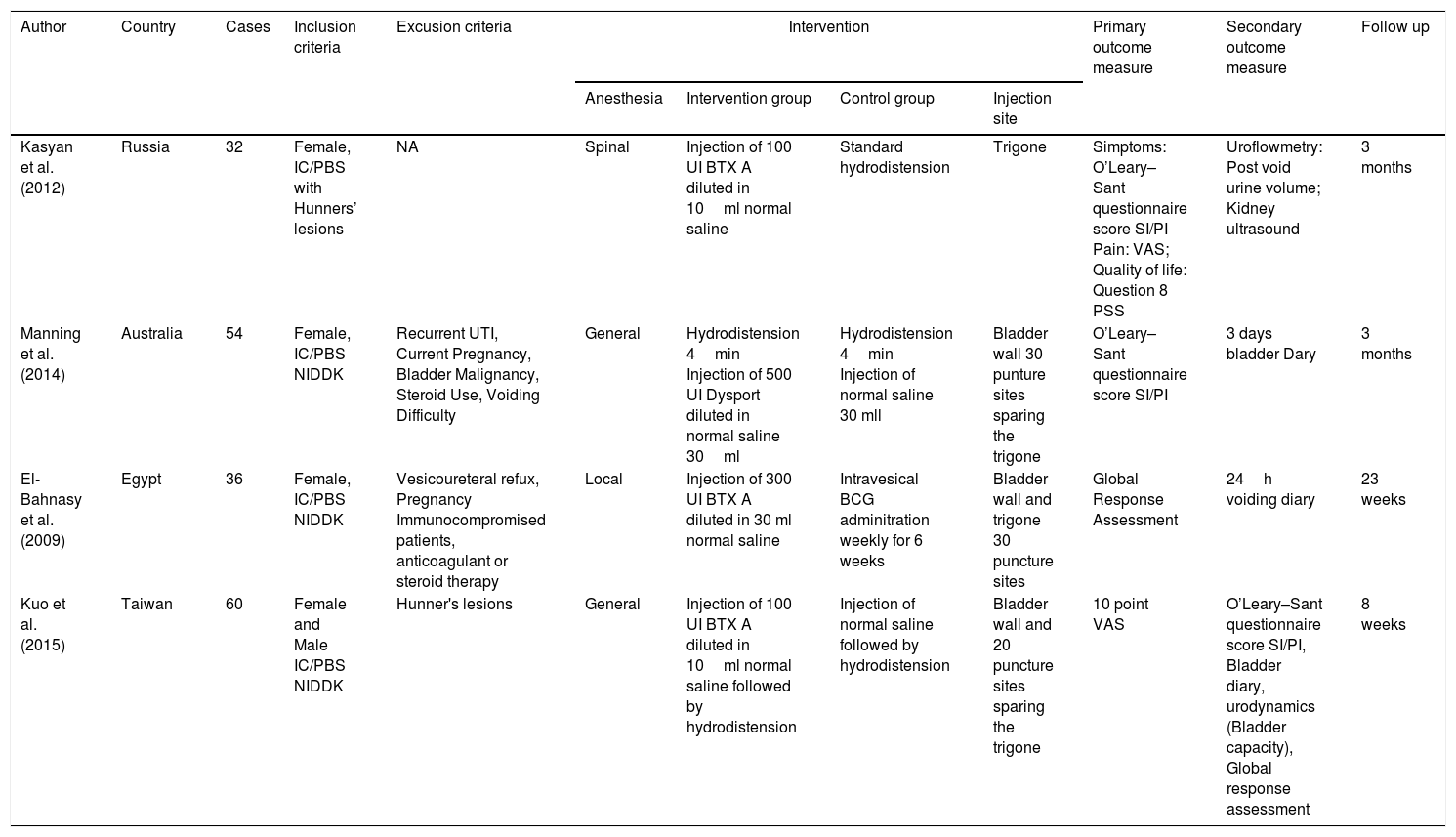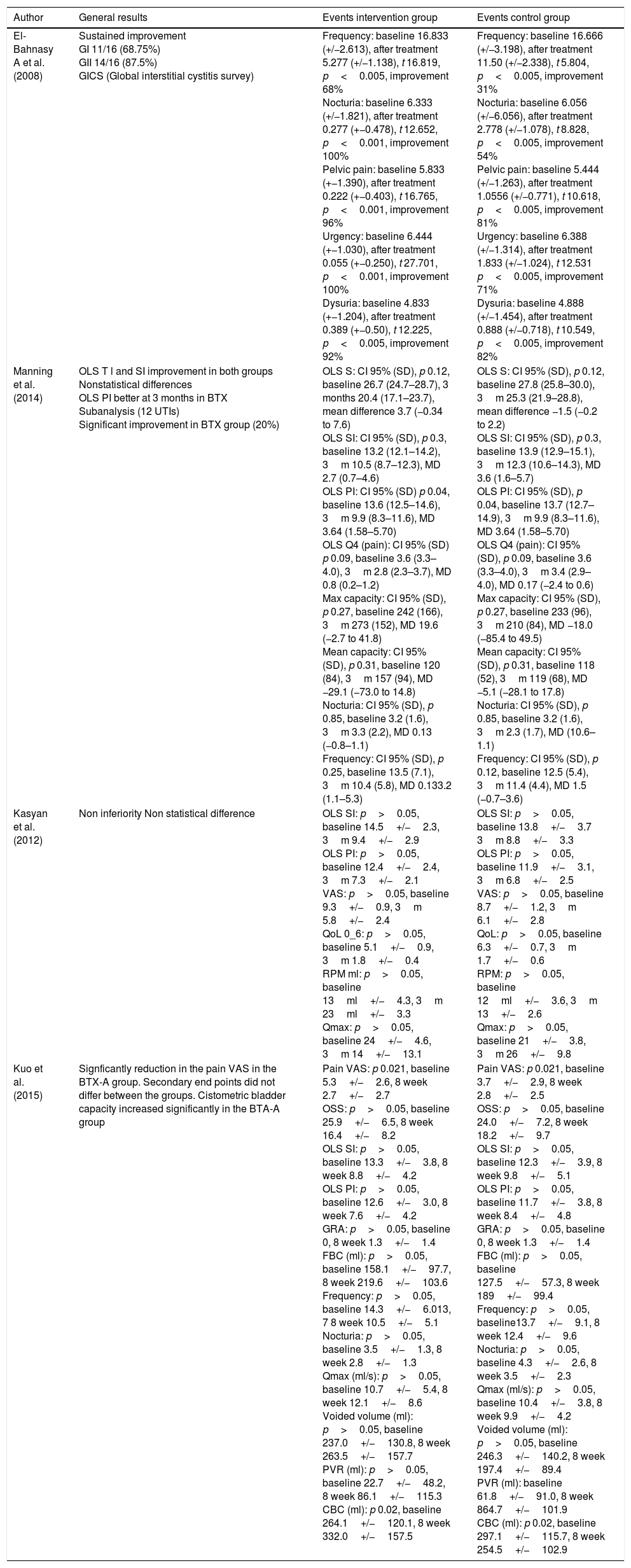To determine the efficacy and safety of BTX-A, compared with other interventions for the treatment of BPS to improve quality of life.
MethodsThis systematic review fulfills all the requirements of the Cochrane manual and PRISMA reporting guidelines. The PROSPERO registration number is: CRD42016039480. Clinical trials without language discrimination were included. BPS patients over 18 y/o that were treated with BTX-A were included. Studies were searched in published databases and no published literature from inception to the present day. Risk of bias analysis was done using the Cochrane risk of bias tool.
Results88 articles were found with the designed search strategies. After exclusions, four studies were included in the qualitative analyses. Kasyan et al. (2012) compared BTX-A with hydrodistention. Manning et al. (2014) compared the injection of BTX-A with the injection of normal saline in previously hydrodistended bladders. In both cases, primary end point was measured by the O’Leary-Sant questionnaire score. El-Bahnasy et al. (2009) compared BTX-A with BCG administration, through Global Response Assessment. Kuo et al. (2015) compared hydrodistention plus suburothelial injections of BTX-A with hydrodistension plus normal saline injections. Reduction in pain was estimated by VAS bladder pain score. A similar efficacy to their controls had been found in Kasyan and Manning studies. El-Bahnasy had found improvement in BTX-A in all parameters. Kuo et al. (2015) found a significantly reduction in pain in the BTX-A group. Regarding the risk of bias, three studies did not have adequate descriptions of selection, performance and detection bias. The study of Manning had low risk of selection, attrition and reporting bias.
ConclusionThere is not enough evidence to conclude the efficacy of BTX-A for the treatment of interstitial cystitis to improve quality of life.
Determinar la eficacia y seguridad de la TXB-A en comparación con otras intervenciones para el tratamiento de SDV para mejorar la calidad de vida.
MétodosEsta revisión sistemática cumple con todos los requisitos del Manual Cochrane y las pautas de PRISMA. El número de registro PROSPERO es: CRD42016039480. Se incluyeron ensayos clínicos sin discriminación idiomática. Los pacientes con SDV mayores de 18 y/o que fueron tratados con TXB-A fueron incluidos. Los estudios se buscaron en bases de datos publicadas y literatura no publicada desde el inicio hasta la actualidad. El análisis de riesgo de sesgo se realizó con la herramienta Cochrane de riesgo de sesgo.
ResultadosSe encontraron 88 artículos con las estrategias de búsqueda diseñadas. Después de las exclusiones se incluyeron 4 estudios en los análisis cualitativos. Kasyan et al. (2012) compararon TXB-A con hidrodistensión. Manning et al. (2014) compararon la inyección de TXB-A con la inyección de solución salina normal en vejigas previamente hidrodistendidas. En ambos casos el principal objetivo se midió mediante la puntuación del cuestionario O’Leary-Sant. El-Bahnasy et al. (2009) compararon la TXB-A con la administración de BCG, a través de la evaluación de respuesta global. Kuo et al. (2015) compararon la hidrodistensión más las inyecciones suburoteliales de TXB-A con hidrodistensión más inyecciones de solución salina normal. La reducción del dolor se estimó mediante la puntuación de dolor vesical EAV. Se había encontrado una eficacia similar a sus controles en los estudios de Kasyan y Manning. El-Bahnasy había encontrado una mejoría en la TXB-A en todos los parámetros. Kuo el al. (2015) encontraron una reducción significativa en el dolor en el grupo TXB-A. En cuanto al riesgo de sesgo 3 estudios no tenían descripciones adecuadas de sesgo de selección, rendimiento y detección. El estudio de Manning tuvo bajo riesgo de sesgo de selección, abandono y notificación.
ConclusiónNo hay suficiente evidencia para concluir la eficacia de la TXB-A en el tratamiento de la cistitis intersticial para mejorar la calidad de vida.











